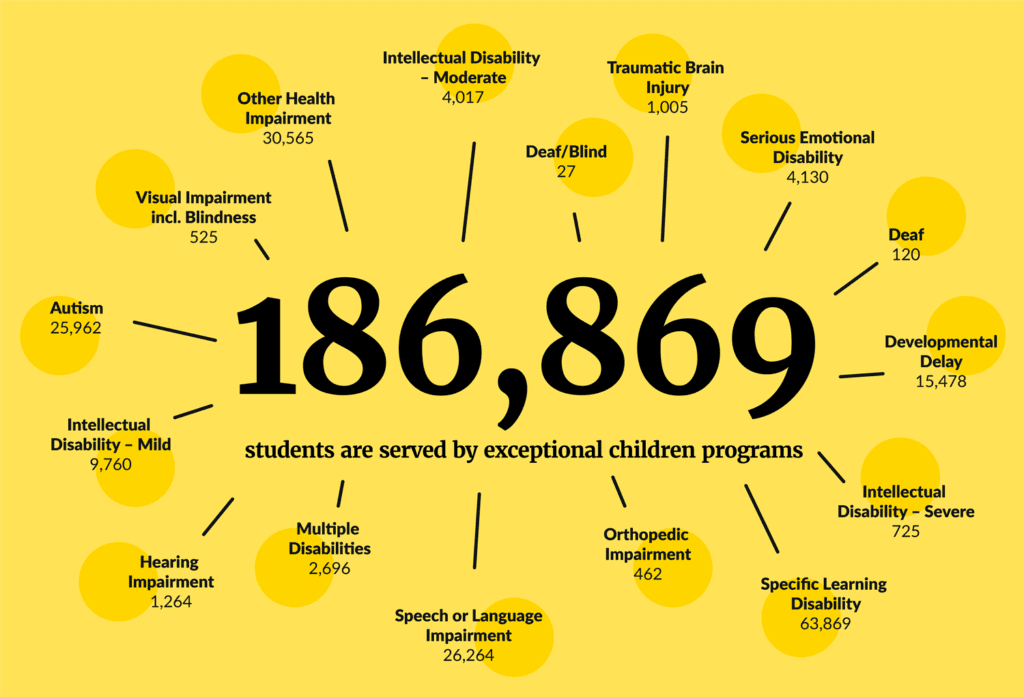
Share this story
- During the last school year, North Carolina had 6,150 teacher vacancies, according to DPI’s State of the Teaching Profession report. Of those, there were 1,203 vacancies for K-12 EC teachers.
- “Finding teachers who are licensed in the area of Exceptional Children also continues to be a challenge for the state’s LEAs," DPI's report on teacher attrition said. Take a look at state and district trends here.
|
|
As teacher turnover and vacancies increased in North Carolina during the 2022-23 school year, districts across the state struggled to fully staff their Exceptional Children (EC) departments, according to data released this month from the Department of Public Instruction (DPI).
North Carolina had 6,150 teacher vacancies on the first day of the 2022-23 school year, according to DPI’s State of the Teaching Profession report, and 6,006 vacancies on the 40th day of school. Of those, there were 1,203 vacancies for K-12 EC teachers — roughly 20% of the state’s teacher vacancies.
While first-year teachers had the highest rate of turnover, the DPI report identified a few department areas with persistent staffing challenges.
“Surveys from a majority of the state’s LEAs show that there is a dearth of teachers licensed in the areas of mathematics and elementary education,” the report said. “Finding teachers who are licensed in the area of Exceptional Children also continues to be a challenge for the state’s LEAs.”
Across North Carolina, some districts had higher proportions of EC teacher vacancies, according to EdNC’s analysis of DPI’s 40th day vacancy data.
Thirteen districts had zero EC vacancies, meaning EC vacancies made up 0% of their total teacher vacancies. In seven districts, 50% or more of the district’s vacancies consisted of EC positions. However, in most of those districts, the total number of teacher vacancies was low.
During the 2022-23 school year, the statewide vacancy rate was 6.4% — up from 5.9% in 2021-22 and 3.4% in 2020-21.
Even with such increases, North Carolina has consistently been able to hire enough teachers to replace the ones who left, according to Dr. Tom Tomberlin, senior director of DPI’s Office of Education Preparation and Teacher Licensure.
However, because North Carolina does not publish the total number of EC positions by district across the state, it is unclear if EC positions are also being replenished.
DPI counts teacher vacancies in the beginning of every year. State law defines vacancies as teaching positions in a district that are not filled by someone with a qualifying educator license. Those licenses include a continuing professional license (CPL), initial professional license (IPL), residency license (RL), or a limited license.
Under that definition, retired teachers, interim teachers, long-term substitutes, and teachers with an emergency or provisional license or a permit to teach do not count as being in a permanent placement.
According to the report, there were 915 more vacancies on the 40th day of school in 2022-23 from the year prior. Some districts had more vacancies on the 40th day than the 1st day.
“In many cases, the positions reported as vacant on the first instructional day were different from those reported as vacancies on the 40th instructional day,” the report says. “This suggests that teacher vacancy is a continual issue that LEAs must contend with throughout the school year.”
You can read DPI’s full attrition report to the General Assembly here. You can also look at DPI’s data dashboard here, which includes data on EC vacancies by district.
To learn more about statewide attrition trends, and strategies in place to build a strong teacher pipeline, read the EdNC article below.
EC students in North Carolina
According to the Institute of Education Sciences 2023 Report on the Condition of Education, “the number of students ages 3–21 receiving special education and/or related services under the Individuals with Disabilities Education Act (IDEA) increased from 6.4 million in school year 2010–11 to 7.3 million in school year 2021–22.”
“Taken as a percentage of total public school enrollment, this equates to an increase from 13 to 15 percent of students,” the report says.
Nationally, American Indian/Alaska Native and Black students had the highest percentage of enrollment in IDEA services in 2021-22, at 19% and 17%, respectively.
In North Carolina, 186,869 students were enrolled across 18 different EC programs during the 2022-23 school year, according to DPI data. You can see the number of students in each of the 18 programs by district as well.
Approximately 34% of these students (63,869) have a “specific learning disability,” which is the largest EC designation in North Carolina and includes dyslexia, dysgraphia, or anything that interferes with a student’s ability to think, speak, write, spell, or do mathematical calculations. This follows national trends included in the Institute of Education Sciences report.

DPI has an Office of Exceptional Children. The office’s mission is to “assure that students with disabilities and those who are academically or intellectually gifted develop mentally, physically, emotionally, and vocationally through the provision of an appropriate individualized education in the least restrictive environment.”
The office’s work is required by federal civil rights law, Section 504 of the Rehabilitation Act of 1973. Section 504 “prohibits discrimination of students on the bases of a handicapping condition.”
“No otherwise qualified individual with a disability in the United States…shall, solely by reason of her or his disability, be excluded from the participation in, be denied the benefits of, or be subjected to discrimination under any program or activity receiving Federal financial assistance. ” U.S. Department of Education.
Requirement under Section 504
Not having enough qualified teachers to serve EC students can put schools at risk of not fulfilling such requirements.
Below, you can look at the number of EC students served in each public school district in North Carolina, along with the number of EC teacher vacancies there.
By clicking on each district in the map, you can see the change in EC vacancies for that district from 2022 to 2023. If the number is positive, that means the district had more EC vacancies in 2023 than 2022, and if the number is negative, the district had fewer EC vacancies in 2023 than 2022.
Read more on EC students



State, district trends in EC vacancies
EdNC’s analysis looks at how much of a district’s overall vacancies consist of EC vacancies.
In 2022-23, 22% of a district’s vacancies on average were in EC departments, based on 40th day vacancy data — up just slightly from the previous two years.
In 2022-23, there were 549 K-5 EC vacancies, 325 at the middle school level, and 329 in high school. Keep in mind that North Carolina has more elementary schools than middle and high schools.
Here’s a look at the number of EC vacancies in North Carolina over the last three years, per DPI’s data dashboard:
- There were 616 EC vacancies in 2020-21.
- There were 900 EC vacancies in 2021-22. The 2021-22 report lists a higher number of vacancies (992).
- There were 1,203 EC vacancies in 2022-23.
As you can see, based on the data dashboard, there were 303 more openings for EC teachers in 2022-23 academic year than the previous year. On average, the number of EC vacancies in districts increased by 55% during the 2022-23 school year from the prior year, per EdNC’s analysis.
The number of EC vacancies also nearly doubled from 2020-21 to 2022-23. However, as mentioned above, the state changed the way it counted vacancies during this time. Now, the vacancy count includes classrooms that have a teacher, but not one who is fully licensed.
In 2022-23, 64 districts had more EC openings than the year before. In 36 districts, the number of EC vacancies decreased. The 15 remaining districts had no change.
Here’s a look at the EC vacancies in North Carolina’s three largest school districts:
- The Wake County Public School System has approximately 116 EC vacancies in 2022-23, making up roughly 17% of the system’s total 40th day vacancies. The number of EC vacancies remained the same from the prior year.
- Charlotte-Mecklenburg Schools had approximately 103 EC vacancies in 2022-23, up from 42 the year before. EC vacancies made up 24% of the district’s total vacancies.
- Guilford County Schools had 10 EC vacancies in 2022-23 and in 2021-22. Last year, this made up 40% of the district’s 40th day vacancies.
Here are the 13 districts that did not have EC vacancies last year: Alleghany, Anson, Ashe, Asheville, Avery, Camden, Clay, Graham, Hyde, Jackson, Mitchell, Tyrrell, and Watauga County Schools.
In Jones County Schools, the only vacancy in 2022-23 was for an elementary school special education teacher.
EdNC’s look at the educator workforce in North Carolina, with a specific lens on teachers working with students in special education, will next look at how district resources aid or impede the recruitment and professional development of those teachers.
Sign up for the EdWeekly, a Friday roundup of the most important education news of the week.
This story was produced with support from the Education Writers Association Reporting Fellowship program.
Recommended reading




